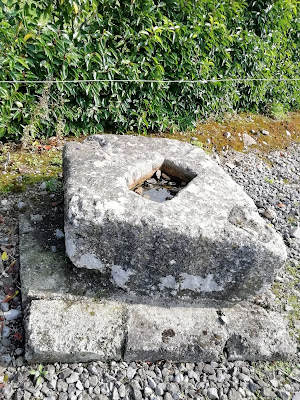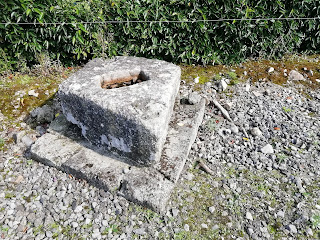Ballylarkin Abbey
Not far from Freshford in Kilkenny and just off to the side of a small Boreen lies an interesting and peculiar building, Ballylarkin Abbey.

The Abbey is in actual fact a small Church and Ballylarkin Abbey is its given "local" name. It's a bit of a curiosity in so much as old obscure Churches often are.
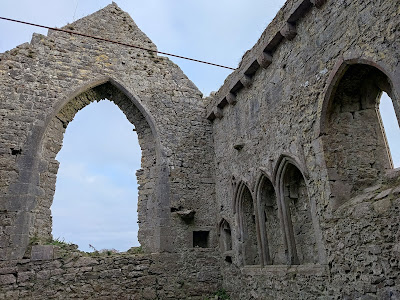
This particular Church has high Parapets that run along either side of the Church, sometimes called Wall Walks or Chemin de Ronde.
Does this suggest that perhaps the Church needed to be heavily defended at one time, who knows for sure?

It is a multi-period Church having seen further construction and additions at several different times in its life but initially constructed some time during the 13th Cty.

There was a Sheela na Gig, a female exhibitionist figure found at the Church and it is now housed in the National Museum at Dublin.

A tunnel has also been described as running from the Church to a Castle just opposite on the other side of the road which only seems to add further to its intrigue.

There are some small ruins across the road and a patch of easily identifiable and partially elevated ground.
There was both an early Castle of some type and a later house here, probably fortified.
The area was initially associated with the Ó'Lorcáins and later the Shorthall family.

Inside there is a Sedilia which seated three and a Piscina. Piscina is a Latin word meaning Fish Pond.
Used in Church references it describes a little wall enclosure in which a small basin has been carved.
It's used for washing liturgical vessels from the celebration of communion or for washing the priests hands.

Often these little basins are carved in a beautiful shell shape like a Clam or Scallop.
There is also a small Aumbrey, a type of small recessed box which would have held the vessels used in the Church ceremonies.

There is an embossed Plaque at the eastern end of the Church which probably came from Ballylarkin Castle across the road and commemorates the Shorthall family. It is believed to date to 1551.

The walls of the Church are quite high in comparison to its overall length and the Western wall is the remaining portion of a now gone tower.
You can clearly see the pitch of the roof defined on this part of the wall and where the roof would have swept down to the defensive Parapets.

The openings into the Church consist of a large Gothic style East window, a small Ogee window in the South wall and a Doorway on a corner of the North wall.

Human remains were found both within and without the Church and suggest an associated Graveyard was once present.

Local tradition holds that there is a tree called the Bishop's Tree in a nearby field.
That field is called the "eleven acres" and folklore tells a tale of 7 Bishops murdered here by Cromwellians in the 1600's.
True or not it goes without saying that we wouldn't hold that particular Parliamentarian at high esteem in Ireland.

The combination of the large Sedilia, the Wall Parapets and the Sheela na Gig seem to suggest that the Church at Ballylarkin was of significant importance to either the local community or the Shorthall family, perhaps both.
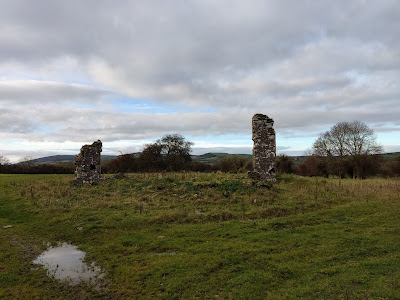
Ballylarkin can be broken down into the Irish word Baile meaning town and Larkin as in the family name Larkin.
The town of the Larkins.
Larkin is the English version of the original Gaelic family name Ó'Lorcáin.

I don't know how accurate it is but I came across a distillery webpage that suggests Augustinian Monks at Ballylarkin once made Irish Liqueur.
I don't usually link to commercial pages but this seemed interesting so there's a link here to Ballylarkin Liqueur.

This Church although small and at first unassuming is worth visiting if in the area. It struck me as a bit of a mystery as to why it seemed to be fortified.

Keep the wheels turning.
Co-ordinates Here :
52.722912
- 7.427906
52°43'22.5"N
7°25'40.5"W







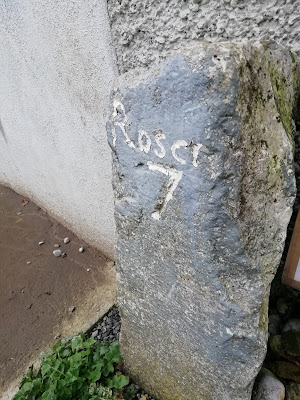



.jpg)
.jpg)
.jpg)
.jpg)

